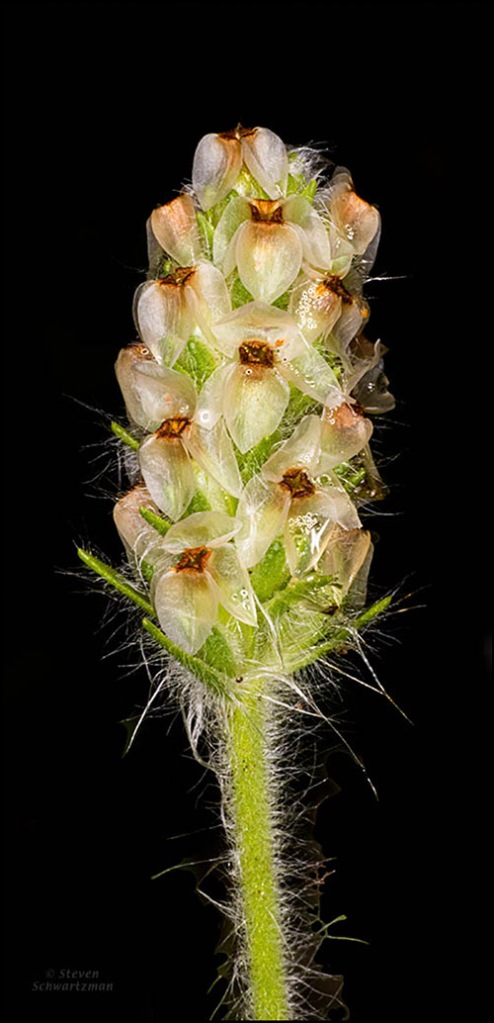Two diminutive inflorescences

Among the least, i.e. smallest, of our daisies is the one known as the least daisy, whose open flower heads measure at most half an inch across (13mm). Travis County is home to two species of Chaetopappa; I don’t know if the one shown above is bellidifolia or asteroides.
Another little cutie is Heller’s plantain, Plantago helleri, which you see below. Both photographs are from April 8th in my northwestern part of Austin.
𝔖
𝔖 𝔖 𝔖
𝔖
Here’s another passage from Helen Joyce‘s 2021 book Trans, whose subtitle is When Ideology Meets Reality.
The magnitude of the male advantage is obvious in sport statistics. The website boysyswomen.com compares the 2016 women’s Olympic finalists with the same year’s finalists in American boys’ high-school competitions. In running, where the male advantage is relatively small, at every distance up to 800 metres the woman who won Olympic gold ran slower than the boys’ qualifying time. The slowest boy to make the finals in the 400-metre hurdles finished faster than every female Olympian, despite having to clear higher hurdles. In the high jump and pole vault, boys would have taken all the medals, and the same in shot put, even though the boys throw a heavier weight. In the long jump no woman would have qualified for the boys’ competition. In swimming, for almost every stroke and distance, no female Olympian would have made it into the boys’ finals.
When you compare women with adult men, and go global, the picture is starker. Every year, in pretty much every athletic event, men break the women’s world record thousands of times. The fastest time ever run by Allyson Felix, the women’s 400-metre Olympic champion, is beaten more than 15,000 times each year by men and boys. In sports where several advantages are compounded, the differences widen into a gulf. In tennis, the fastest recorded serve by a man is 163 miles per hour; by a woman, 137. The most aces hit in a men’s tennis match is 113; in a women’s match, it’s 31. And these statistics barely begin to capture the differences in game-play.
© 2023 Steven Schwartzman











Wonderful photography!
The first flower appears to have no home in Florida.
As for Plantago, ten species are listed but only two occur in my particular area. I’m not certain about all Plantago, but the leaves of P. virginica are fine in a salad and sauteed as one would kale or chard.
Wally Jones
May 6, 2023 at 10:56 AM
With all the people who have moved to Florida recently, it’s no wonder the least daisy can’t find a home there. Your mention of Plantago virginica “in a salad and sauteed as one would kale or chard” is the first time I’ve heard that people eat any of the species in this genus. A Eurasian Plantago grew in people’s lawns on Long Island when I was growing up (and presumably still) but no one gave a thought to eating one.
Steve Schwartzman
May 6, 2023 at 11:16 AM
I love the detail of the plantain image, especially the translucence of the tiny petals.
Ann Mackay
May 7, 2023 at 6:26 AM
I also find that translucence an endearing feature of this plantain.
Steve Schwartzman
May 7, 2023 at 6:55 AM
Down here on the coast, Chaetopappa asteroides would be the more certain bet, since C. bellidifolia isn’t shown anywhere near our area. It certainly is a pretty thing. I’ve only seen Heller’s plantain in the hill country around Kerrville. I think it’s as pretty (and more interesting) than the aster.
I have vague memories of one of my grandmother’s neighbors cooking up a combination of plantain and dandelion greens. It seems that all of the species are edible. I only stripped off the seeds when I was preparing a meal for my dolls, c. 1950.
shoreacres
May 8, 2023 at 6:40 AM
We—like just about everybody—had dandelions and plantain in our lawn on Long Island. Think of all the food we passed up, not knowing both are edible.
I look forward to Heller’s plantain each spring, not only for its intrinsic appeal, but also because it’s one Plantago that I easily recognize and know is native. With various other species, I’m not sure of the identification or the origin.
Steve Schwartzman
May 8, 2023 at 7:04 AM
[…] spring I brought you a first, a second, and a third excerpt from mathematician and journalist Helen Joyce’s book Trans. Here’s a capsule […]
Balsam gourd | Portraits of Wildflowers
July 22, 2023 at 4:24 AM